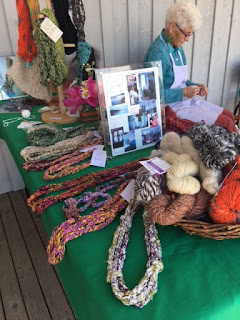Fall is definitely in the air as we fast approach the middle of October, and I have a few things to catch you up on.
First, let me congratulate and thank The Island (PEI) Knitters Club on a terrific seminar a couple of weeks ago. This year's presenter was Diana Sullivan (link in the sidebar), and it was wonderful to meet her in person and get a great refresher on many useful techniques. The seminar was very well attended, and it was also nice to see many familiar faces, as well as meet new people, and as always come home inspired. Here are some random pictures from the weekend.
Next year's seminar will be hosted jointly by the Annapolis Valley Machine Knitting Guild and the Metro Machine Knitters. Here is a note from the president of the Annapolis Valley group:
The two Nova Scotia groups, Annapolis Valley
Machine Knitters and Metro Machine Knitters, will host a knitting weekend
similar to the one we hosted in 2016. It will again be held at the Lions Club
Hall in Wolfville. The dates are Friday, September 27 and Saturday, September
28, 2019. Lunch will be served by the Lions on both days. Our first knitting
weekend proved to be a fun time. We all got to knit and learn new techniques
and be refreshed in old techniques. Our membership numbers are quite low and a
seminar with a presenter just isn't within our monetary range anymore. We found
our knitting weekend less stressful to host.
In the coming months you will be receiving updates on registration costs, etc. We would appreciate input from you on what you might like to do and any ideas that you may have. I hope you will consider attending as there seems to be more inter-connecting among attendees at a function such as this.
I heard that everyone thoroughly enjoyed the PEI Seminar and Diana Sullivan. I am very sorry that I could not attend. Looking forward to seeing you in Wolfville, N.S. in September 2019.
Linda Wood-Carey
In the coming months you will be receiving updates on registration costs, etc. We would appreciate input from you on what you might like to do and any ideas that you may have. I hope you will consider attending as there seems to be more inter-connecting among attendees at a function such as this.
I heard that everyone thoroughly enjoyed the PEI Seminar and Diana Sullivan. I am very sorry that I could not attend. Looking forward to seeing you in Wolfville, N.S. in September 2019.
Linda Wood-Carey
We have two events coming up on Saturday, October 27, both in Musquodoboit Harbour. The first is our next library get-together. Here is a word from Lynne about that:
On
October 27 from 10am until 5pm The Eastern Shore Gang will be hosting an MK
Workshop at the Musquodoboit Library.
The
PEI seminar with Diana Sullivan has inspired all of us who attended to dig out
our garter bars, dust them off, and work our way through the exercises in the
seminar booklet.
I
will also circulate a simple toque pattern that you can make on your machine
with a garter bar or by using waste yarn.
The
library can accommodate ten Knitters in the multi purpose room with tables and
chairs provided. There is also a
kitchen to heat up lunches or to make a cup of tea or coffee (you bring
supplies).
Here is what you need to bring;
A machine and appropriate garter bar. MK
tools, weights, etc., yarn appropriate to your machine, a mix of light colours
is a good idea, and lunch (we’ll take a break at 12:30 and there is a bakery
and a few food outlets close by).
It will be a day of sharing what we
learned at the seminar, and asking for help when our memories fail us.
Please let me know if you plan to attend
so we can let the library know how many people to expect and to have extra
tables set up if needed.
I’m looking forward to using my garter
bar that I have neglected for far too long.
Hope to see you!
Lynne
Please let us know if you are able to come by emailing Lynne or leaving a comment below.
And on the same day, there will be a Fibre Festival at the Old School Community Gathering Place. Here is information on that:
I have been busy imagining and planning my new studio in our new house, currently under construction, so although I am separated from my machines and most of my yarn and other "stuff" that is in storage, I am the luckiest person in the world to have this opportunity to create a whole new, spacious space in which to create. Here is a sneak peak at this work in progress.
Until next time,
Nancy


















































